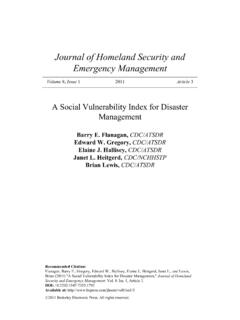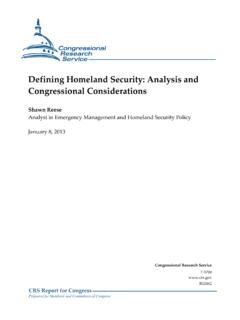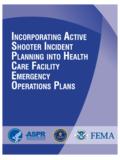Transcription of Emergency and Disaster Management Case Study
1 0 Emergency and Disaster Management Case Study Standing Panel on Intergovernmental Systems March 2020 Page is intentionally blank The National Academy of Public Administration (the Academy) is an independent, nonprofit, and nonpartisan organization established in 1967 to assist government leaders in building more effective, accountable, and transparent organizations. Chartered by Congress to provide nonpartisan expert advice, the Academy s unique feature is its over 900 Fellows including former cabinet officers, Members of Congress, governors, mayors, and state legislators, as well as prominent scholars, business executives, and public administrators. The Academy helps the federal government address its critical Management challenges through in-depth studies and analyses, advisory services and technical assistance, congressional testimony, forums and conferences, and online stakeholder engagement.
2 Under contracts with government agencies, some of which are directed by Congress, as well as grants from private foundations, the Academy provides insights on key public Management issues, as well as advisory services to government agencies. Copyright 2020 by National Academy of Public Administration. All rights reserved. Published and hosted by the Academy. i Emergency AND Disaster Management CASE Study NATIONAL ACADEMY OF PUBLIC ADMINISTRATION STANDING PANEL ON INTERGOVERNMENTAL SYSTEMS Contributors Katherine G. Willoughby Donald Bathurst Gregory Devereaux Kay C. Goss Elizabeth Kellar Shelley Metzenbaum John Ten Hoeve Louis W. Uccellini 1 PROBLEM DEFINITION, WHEN POLICY WORKS AND POSSIBLE ROLES Brief overview of policy problem (opportunity). Every year, natural and unnatural disasters not only put people living in the whole of the United States, including its territories, at great personal risk of life and injury, but also put at risk the well-being of their property and the communities in which they live.
3 Such risks are growing precipitously given that the average yearly number of Disaster declarations has increased substantially in the last 50 years. These include tornadoes, hurricanes, severe snow and ice, severe storms, earthquakes, wildfires, mudslides, floods, tsunamis, typhoons, and one volcanic eruption. In the ten year period from 2007 to 2016, the federal Emergency Management Agency (FEMA) lists 614 major Disaster declarations across the 50 That is, from 1960 to 1979, the average annual number of Disaster declarations equals 32 and from 1980 to 1999, this average grows to 51. I n the first two decades of the 21st century, the average explodes to 124. Congressional staff note climate change as well as policy and administrative changes, population growth, and development patterns as just a few reasons for these increasing declarations (Lindsay and McCarthy, 2015).
4 Disasters can have significant and depleting immediate and long-lasting impacts on government budgets and finances, as well, and these impacts may be difficult, if not impossible, to recover from. The National Oceanic and Atmospheric Administration (NOAA) National Centers for Environmental Information (NCEI, 2019) estimates that the nation has experienced 254 weather and climate disasters from 1980 to the present for which total costs exceed $ trillion. I n 2019 alone (as of October 8), there have been ten weather and climate Disaster events with losses exceeding $1 billion each across the United States (NCEI, 2019). 1 From FEMA, Does not account for three other FEMA designations Emergency declaration, fire Management assistance declaration, and fire suppression authorization. 2 Further complicating relief efforts, governments may need to battle multiple, successive strikes of one type of Disaster and/or the simultaneous occurrence of different types of disasters.
5 For example, many western states and localities must manage wildfires year-round; the mid-west often experiences a string of tornadoes, one after the other, during storm season; and the east coast is usually hit annually with hurricanes, of various intensities. Layer on top of these natural disasters, the plausibility of unnatural ones occurring at the same time and in the same place, such as a mass shooting, plant explosion, train derailment, contamination of the water system, a government ransomware hack, and/or the current, catastrophic global Coronavirus pandemic, and the policy problem becomes extraordinarily clear. I t is imperative that governments work together to prepare and respond efficiently and effectively amid inevitable disruption and destruction that Disaster brings. This is in spite of the fact that in every case, the context of the community, the extant Disaster , and the process of recovery are unique.
6 That is, no two communities are exactly alike in capacity to withstand Disaster , adapt to new circumstances following Disaster , and ultimately, to restore, rebuild and mitigate in the aftermath of Disaster . When policy implementation works. Prevention, preparedness, response, and recovery these are the overarching objectives of an effective Emergency Management system. Such a system helps prevent and deter natural and unnatural disasters in effective, fiscally sustainable, and equitable ways. This system assists people and communities to prepare for events that otherwise cannot be prevented in effective, affordable, fair, compassionate, and increasingly cost-effective ways. Such systems can respond to and help communities hit by disasters and the people who previously lived in them to recover as quickly and completely as possible in fast, fair, compassionate, cost-effective, accountable, and honest ways.
7 Possible roles of federal /state/local/regional levels of government. federal , state, local, tribal and regional organizations all play critical roles helping people and their communities prevent Disaster -related risks, prepare for disasters that cannot be prevented, respond when they occur, and recover after they happen. Governments do this by working separately and together, and often with a variety of other non-governmental partners. G overnments are most successful when they 3 work together seamlessly, as each can bring to Emergency Management efforts distinct, but potentially complementary, perspectives. Local governments are on the ground level, closest to the people and communities affected. They can respond more quickly in the aftermath of a Disaster , but also can put in place prevention mechanisms prior to Disaster , such as building codes, Emergency preparedness drills, and continuity of operations, sustainability and/or resiliency plans that reduce the costs of recovery after Disaster .
8 However, while local governments have the highest stake in a quick response and strong recovery for affected communities, especially if they are low income or small communities, they may have the least capacity for effective response and recovery. States and regional organizations can coordinate recovery efforts that span local borders while the federal government can coordinate efforts that span state borders. States can broker, coordinate and/or consolidate communication, Management and fiscal flows to advance more efficient and effective recovery at lower levels. States and regional organizations can provide training, supplies, and services to bolster local efforts to mitigate damages resulting from Disaster . Together with the federal government, states provide consequential research and evaluation that can inform recovery efforts at the ground level. The federal government can provide funding that, if ably and smoothly channeled to the ground level in a timely way, can bolster a community s ability to return to business as usual.
9 The federal government spreads the risk associated with Disaster by sharing data and scaling responsibilities and Management (such as for purchasing) that can strengthen both state and local efforts to recover from Disaster . Below we consider what has worked and what has not regarding Emergency Management in light of Disaster and given how roles have operated in the past. Then, we articulate what has been learned from past experiences to inform the necessary transformation of roles and restructuring of responsibilities to support Emergency Management systems that can realize the objectives of effective and efficient prevention, preparedness, response and recovery to the broadest array of natural disasters possible. 4 Disaster EXPERIENCES AND LESSONS LEARNED What has worked and what has not. To discern definitely what works and what does not in the event of Disaster is virtually impossible.
10 As noted earlier, every community is unique as is every Disaster ; recoveries are distinctive in that no two are alike. What works well in one instance, may not work at all in another. Still, this case presents numerous examples of how Emergency Management strategies and Disaster preparation and mitigation efforts have evolved over time and resulted in the development of principles and tools that can be engaged for better outcomes. For it is by exposure to others experiences, learning from these experiences, contemplation of multiple possible Disaster scenarios, and practice of response strategies that can help those on the ground level be able to respond more quickly, critically and effectively if and when Disaster strikes. Hurricane Katrina Consider the case of Hurricane Katrina, a catastrophe of historic proportions that required a first ever evacuation of New Orleans, Louisiana and ended in the displacement of million people across the United States (G odfrey, 2009).




